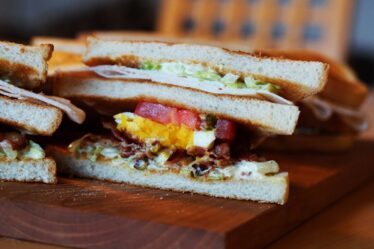
Cauliflower pizza crust has emerged as a popular alternative to traditional wheat-based crusts, catering to individuals seeking low-carbohydrate, gluten-free, or vegan options. This innovative crust utilizes cauliflower, a nutrient-dense cruciferous vegetable, as its primary ingredient. The rise in popularity of cauliflower pizza crust can be attributed to its nutritional benefits and versatility, making it suitable for various dietary needs and preferences.
The process of creating cauliflower pizza crust involves finely chopping or processing cauliflower florets into a rice-like consistency, then cooking and draining the excess moisture. The resulting cauliflower “rice” is combined with binding ingredients such as eggs or plant-based alternatives, herbs, and seasonings to form a dough-like mixture. This mixture is then shaped and baked to create a crisp, flavorful base for pizza toppings.
Cauliflower pizza crust offers several nutritional advantages over traditional crusts. It is significantly lower in carbohydrates and calories, higher in fiber, and provides essential vitamins and minerals found in cauliflower. Additionally, it serves as an excellent way to increase vegetable consumption in one’s diet, contributing to overall health and wellness.
Key Takeaways
- Vegan cauliflower pizza crust is a healthy and delicious alternative to traditional pizza crust, perfect for those following a plant-based diet or looking to reduce their carb intake.
- Using cauliflower as a pizza crust alternative provides numerous benefits, including being low in carbs, high in fiber, and packed with essential nutrients.
- The ingredients for vegan cauliflower pizza crust are simple and include cauliflower, flaxseed meal, nutritional yeast, and seasonings, making it an easy and accessible recipe for many.
- Step-by-step instructions for making vegan cauliflower pizza crust involve processing the cauliflower, mixing it with the other ingredients, shaping the crust, and baking it to perfection.
- Tips for perfecting your vegan cauliflower pizza crust include thoroughly squeezing out excess moisture from the cauliflower, using parchment paper for easy removal, and pre-baking the crust before adding toppings for a crispier result.
- Vegan cauliflower pizza crust pairs well with a variety of toppings such as marinara sauce, vegan cheese, and an assortment of vegetables, offering endless possibilities for creating delicious and nutritious plant-based pizzas.
- In conclusion, vegan cauliflower pizza crust is a versatile and healthy option for pizza lovers, providing a satisfying and nutritious alternative to traditional crusts.
Benefits of Using Cauliflower as a Pizza Crust Alternative
Low in Carbohydrates
Cauliflower is an ideal choice for those looking to reduce their carb intake or follow a low-carb diet, as it is naturally low in carbohydrates. This makes it a suitable option for individuals with diabetes or those looking to manage their weight.
Gluten-Free and Inclusive
Additionally, cauliflower is naturally gluten-free, making it a great option for individuals with gluten sensitivities or celiac disease. This makes cauliflower pizza crust a versatile and inclusive option for those with dietary restrictions.
Nutrient-Dense and Healthy
Furthermore, cauliflower is a nutrient-dense vegetable, rich in vitamins, minerals, and antioxidants, making it a healthy choice for anyone looking to boost their nutrient intake. By using cauliflower as a pizza crust alternative, you can enjoy the health benefits of this nutritious vegetable while still indulging in a delicious and satisfying meal.
Ingredients and Preparation for Vegan Cauliflower Pizza Crust

To make vegan cauliflower pizza crust, you will need a few simple ingredients. The main ingredient is, of course, cauliflower, which should be finely grated or processed into rice-like grains. You will also need flaxseed meal, which acts as a binding agent in place of eggs, making the crust vegan-friendly.
Additionally, you will need nutritional yeast, which adds a cheesy flavor to the crust without the need for dairy. Other ingredients include garlic powder, oregano, salt, and pepper, which add flavor to the crust. Once you have gathered all the necessary ingredients, the preparation process involves mixing the grated cauliflower with the flaxseed meal, nutritional yeast, and seasonings until a dough-like consistency is formed.
This mixture is then pressed into a pizza crust shape and baked until golden and crispy.
Step-by-Step Instructions for Making Vegan Cauliflower Pizza Crust
| Ingredients | Measurements |
|---|---|
| Cauliflower | 1 head |
| Flaxseed meal | 1/4 cup |
| Almond flour | 1/4 cup |
| Italian seasoning | 1 tsp |
| Salt | 1/2 tsp |
| Garlic powder | 1/2 tsp |
| Olive oil | 1 tbsp |
| Tomato sauce | 1/2 cup |
| Vegetables (toppings) | As desired |
To make vegan cauliflower pizza crust, start by preheating your oven to 400°F (200°C) and lining a baking sheet with parchment paper. Next, prepare the cauliflower by removing the leaves and stem and cutting it into florets. Place the florets in a food processor and pulse until they resemble rice-like grains.
Transfer the processed cauliflower to a microwave-safe bowl and microwave for 4-5 minutes until softened. Once the cauliflower has cooled, place it in a clean kitchen towel and squeeze out any excess moisture. In a separate bowl, combine the cauliflower with flaxseed meal, nutritional yeast, garlic powder, oregano, salt, and pepper.
Mix until well combined and a dough-like consistency is formed. Transfer the mixture onto the prepared baking sheet and shape it into a round pizza crust, about ¼ inch thick. Bake the crust for 25-30 minutes or until golden and crispy.
Once baked, remove the crust from the oven and add your favorite toppings before returning it to the oven to bake for an additional 10-15 minutes.
Tips for Perfecting Your Vegan Cauliflower Pizza Crust
To ensure that your vegan cauliflower pizza crust turns out perfectly, there are a few tips to keep in mind. Firstly, it is important to remove as much moisture from the cauliflower as possible before mixing it with the other ingredients. Excess moisture can result in a soggy crust, so be sure to squeeze out any water using a kitchen towel or cheesecloth.
Additionally, be mindful of the thickness of the crust when shaping it on the baking sheet. A thinner crust will result in a crispier texture, while a thicker crust may require longer baking time. It is also important to pre-bake the crust before adding toppings to ensure that it holds its shape and becomes crispy.
Finally, be creative with your toppings and pairings to enhance the flavor of your cauliflower pizza crust. Consider using fresh vegetables, vegan cheese, and flavorful herbs to create a delicious and satisfying pizza experience.
Toppings and Pairings for Vegan Cauliflower Pizza Crust

Fresh Vegetables and Vegan Cheese Alternatives
You can customize your pizza with an array of fresh vegetables such as bell peppers, onions, mushrooms, spinach, and cherry tomatoes for added color and flavor. For a cheesy finish without dairy, consider using vegan cheese alternatives made from ingredients like cashews or nutritional yeast.
Adding Plant-Based Protein and Flavor
Additionally, you can add plant-based protein sources such as tofu, tempeh, or chickpeas to make your pizza more filling and satisfying. To enhance the flavor of your pizza, consider using aromatic herbs like basil, oregano, thyme, or rosemary. You can also drizzle your pizza with a balsamic glaze or sprinkle it with red pepper flakes for an extra kick of flavor.
Pairing Options for a Complete Meal
When it comes to pairings, consider serving your cauliflower pizza with a fresh green salad or roasted vegetables for a complete and balanced meal.
Conclusion and Final Thoughts on Vegan Cauliflower Pizza Crust
In conclusion, vegan cauliflower pizza crust is a delicious and nutritious alternative to traditional pizza crust that offers numerous health benefits and versatility. By using cauliflower as a base, you can enjoy a low-carb, gluten-free, and nutrient-dense pizza crust that is suitable for individuals with dietary restrictions or those looking to make healthier food choices. With the right ingredients and preparation techniques, you can create a crispy and flavorful crust that serves as the perfect canvas for your favorite toppings and pairings.
Whether you are following a vegan diet or simply looking to incorporate more vegetables into your meals, vegan cauliflower pizza crust is a great option for satisfying your pizza cravings while nourishing your body with wholesome ingredients. So why not give it a try and experience the deliciousness of homemade vegan cauliflower pizza crust for yourself?
If you’re looking for more unique and flavorful recipes, you might enjoy learning about the ugli fruit in this article. This tropical fruit has a sweet and tangy flavor that can add a refreshing twist to your meals.



